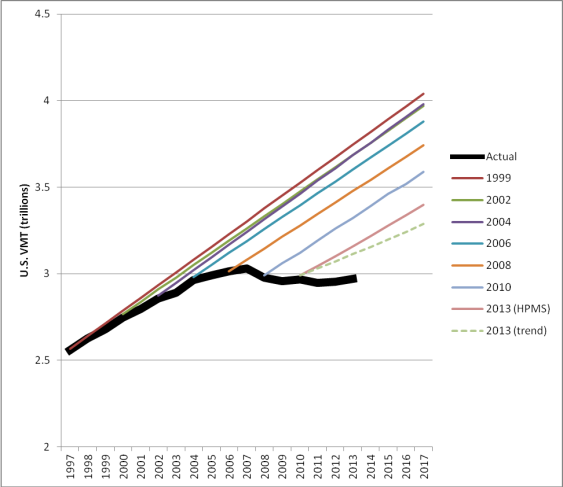There’s an old fable about a scorpion and a frog: the frog generously offers to carry a scorpion across a river…but halfway across, the scorpion stings the frog, drowning them both. With its dying breath, the frog asks why the scorpion did something so stupid, and the scorpion replies: “I can’t help myself. Stinging is what scorpions do!”
I thought of this fable when a saw this new chart from the State Smart Transportation Initiative, comparing the US Department of Transportation newest vehicle travel forecasts with previous versions. Like the scorpions in the fable, it seems the nation’s traffic forecasters just can’t help themselves: forecasting rapid traffic growth is just what DOTs do.
The thick black line represents actual traffic trends. The thinner colored lines represent forecasts from different vintages of the USDOT’s Conditions and Performance report.
As SSTI notes, the solid colorful lines represent the “roll up” of traffic forecasts made by individual state highway agencies. Clearly, the traffic forecasters at most state DOTs have learned almost nothing from a decade of more-or-less flat vehicle travel.
The dotted green line, however, seems to be USDOT’s attempt to develop a more nuanced forecast, based on actual traffic growth over the 15 years prior to 2010. But even that forecast is already badly wrong!! It projected 1.36 percent annual traffic growth, starting in 2010. The actual trend: -0.7 percent, +0.3 percent, and +0.6 percent. That adds up to almost no net growth since 2010, instead of the extra 120 billion miles of vehicle travel the USDOT had been projecting.
The scorpion could blame its DNA. But the stubbornness of transportation professionals requires a different explanation. One place to start is to look at the incentives that DOT forecasters (and their bosses) face. Many state DOTs exist largely to plan and execute major highway expansion projects. So if the forecasters aren’t projecting rapid growth, the new highways may not seem all that necessary…and the gravy train of new projects could dry up.
So perhaps the reason that state DOTs don’t make accurate forecasts is that they simply can’t afford to make accurate forecasts. After all, as Upton Sinclair famously noted, “It is difficult to get a man to understand something, when his salary depends upon his not understanding it.”
Hat tips to Eric Sundquist and Joe Cortright.









Weezy
The incredibly-overstated traffic projections Sound Transit used as “justification” for its train megaprojects are the product of exactly the same self-interest bias.
Matt the Engineer
Yet Link is in double digit percentage ridership growth and is accelerating. The original projections included U-Link, and we’ll see what happens once U-Link actually opens…
Weezy
???
The light rail ridership numbers here are terrible. The capacity for light rail systems is 20 – 25,000 boardings per hour:
http://www.prnewswire.com/news-releases/frost–sullivan-north-american-light-rail-transit-market-in-north-america-becoming-more-competitive-248532391.html
That’s about the average DAILY ridership in Seattle.
Let’s see if you are any better with facts and figures relevant to Clark’s piece here, Matt. Take East Link. The traffic projections for the I-90 bridge used to “justify” East Link came from a 2004 study, right? What were the projected traffic levels in that study? That was a decade ago: let’s compare those projections with the reality today.
Clark Williams-Derry
I think that Weezy is correct that Sound Transit’s ridership remains well behind the original forecasts, and that a big part of the reason is that the original forecasts that were used to justify the project were flawed.
But Matt, you are also correct: Central Link ridership continues to grow. Despite Weezy’s unnecessary, pointless, and off-putting rudeness to you, he’s pointed out no evidence to undermine your point.
He’s also cherry-picked a number that has no obvious relevance to Sound Transit light rail — though it does point out the potential of high-frequency transit (BRT or light rail), and also the fact that Link, like most peer systems, lags far behind that potential.